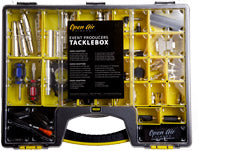
High-quality, well-kept cables are the lifeblood of your outdoor cinema event. You may have the finest projector in all the land and speakers so crisp and clear you'd think the actors on screen are actually just bouncing their voices off the inside walls of your skull - but without the cables to connect everything together, you have just a bunch of expensive weights, better for keep a tarp from blowing away than for showing films.
The cable's job is to transmit digital signals from the video source to the projector and the speakers. But if you think of the cable as simply a hallway which little digital pulses and blips travel, you're understating the process a great deal. In order to better understand how to choose good cables and how to keep them in good maintenance, it behooves the aspiring event producer to know a thing or two about the anatomy of the cable.
The Jacket
Let's start with the exterior of the cable - the epidermis, if you will. The outside of the cable is known as the jacket. It is usually made from low-density polyethylene plastic, which is treated with UV rays on the chance that the cable is exposed to sunlight. Prolonged exposure to the sun can adversely affect the cable's insulation properties. If your cable is black in color, it generally means that it has been treated and is UV resistant. But, that doesn't mean that cables of different color jackets cannot be just as effective or of high quality.
The Braided Shield
The next thing you'll find in a cable is the braided shield. When a cable is shielded, it means that it has one or more insulated conductors enclosed by a conductive layer, usually from aluminum or copper. Shielding is designed to ensure that the signal traveling through the cable doesn't interfere with other signals or nearby circuitry. You typically want a shield to cover 95% of your cable. The more shielding on your cable, the better.
The Foil Shield
As fantastic as a braided shield may be against electromagnetic interference, it will not protect your cable against radio frequency interference, or RFI. Radio frequency interference is just what it sounds like - you ever hear a walkie-talkie or a guitar amp inexplicably pick up an old ranchero from the Spanish radio station at the tail end of the dial? That is RFI. A foil shield in your cable will protect you from unwanted RFI, so that your outdoor cinema experience isn't mitigated by unwanted DJ chatter or police scanner. Not all cables come with foil shield, so be sure to specifically look amongst the cables' specs before you buy.
The Dielectric
The dielectric is the means by which the conductors in a cable are separated, to ensure that they do not interfere with each other and disrupt the signals. Frankly speaking, air is the best dielectric material out there. However, it is nigh unto impossible to design a cable wherein multiple conductors are isolated by the air. To get the same dielectric value of 1 that air has, manufacturers will inject nitrogen or another gas into a tube of polyethylene or teflon to get the same effect.
The Conductor
The conductor is where it all happens. It's the jumping off point for the electrical energy that has been traveling through the inner anatomy of your cable - the means by which all of those audio and video signals are sent to their designated receiver. When it comes to the conductors in your cables, you want to examine three things: the material it's made from; the gauge of the conductor; and whether the conductor is solid or stranded. In terms of material, silver is the most effective, followed by copper, and then gold. Copper has become the most popular type of conductor, because it is effective and generally cheaper. The gauge of the conductor will affect its overall resistance. The larger the diameter of the conductor, the lower its resistance. Finally, the difference between a solid conductor and stranded conductor is minimal - a stranded conductor allows the cable to bend more easily.
Now that you know about the internal anatomy of the standard cable, you'll have an easier time selecting ones that will perform at the level you require for your outdoor cinema event. You'll also be more mindful when coiling them and storing them in between events. If you treat your cables right, both inside and out, they'll last a long time.






